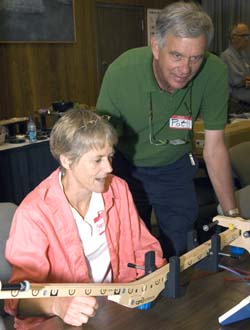Always use caution when entering a room filled with physics teachers.
You’re liable to get hit with flying marbles, step on an out-of-control toy car, or hear the strange buzzing of strings vibrating in harmonic patterns.

Physics has a reputation for being the toughest of the high school science courses. But visual models of motion, acceleration, waves, projectiles and other principles help students of all ages build an understanding of physical science concepts.
For Jack Wiegers, biology instructor, and Patrick Gibbons, Ph.D., professor of physics, both in Arts & Sciences, these ideas are a key part of science for students from kindergarten through grade 12. The pair instructs four Science Outreach graduate courses in physical science designed for K-8 teachers. They’ve also worked with high school teachers in short workshops and in year-long professional learning communities. And in the spring, they’re adding their first graduate credit course for high school teachers to their repertoire, a course in mechanics and thermodynamics.
Gibbons’ and Wiegers’ move into high school physics curriculum has been prompted by some local districts’ adoption of the “physics first” curriculum order. First suggested in the 1980s then championed in the 1990s by Nobel laureate physicist Leon Lederman, the movement recommends teaching physics to high school freshmen, followed by chemistry to sophomores and biology to juniors.
“The foundational idea is that physics supports learning of chemistry, and that since 1980 at least, knowledge of chemistry is needed to understand modern molecular biology,” says Gibbons. “So teaching physics at an appropriate level to ninth graders, followed by chemistry adapted for sophomores and then molecular biology for juniors is educationally sound.” By senior year, Gibbons says, a student would choose an honors or AP course in any of the sciences.
Many local districts have implemented physics in the ninth grade, including several that have done so with support from a University of Missouri-Columbia and Department of Elementary and Secondary Education program named A TIME for Physics First.
Teachers of grades 7-12 from across the area participated in workshops and professional learning opportunities in physical science this summer through Science Outreach. Steve Burgess, physics teacher from McCluer North in Ferguson-Florissant, says his district switched to ninth grade physics three years ago.
“We found problems in math,” he says, referring to students’ readiness to tackle more difficult physics. “But reaching students who are still young enough to develop good science and math habits has been great,” he adds.
Teachers and districts have developed a variety of ways to solve the math readiness problem and to create visual demonstrations. Melinda McElligott, seventh grade science teacher at Montgomery County Middle School visited Washington University in July for a workshop on using CPO Science materials for physics. “We do Newton’s laws, weather and climate because they’re in the Missouri GLEs [grade level expectations],” she explains. She says that even though her district can’t afford to purchase the CPO kits, she gets ideas for creating visuals for students using materials she has.
For teachers of physics and physical science across grades, then, the rules are creativity and adaptability. And watch out for flying marbles.